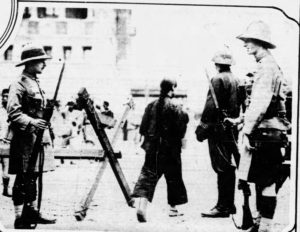Posted: December 11th, 2016 | No Comments »
Saw somewhere that John Milton, the poet, author of Paradise Lost and other works, polemicist was born this week in 1608.
Blind John Milton (1608-74) was born into the height of the Protestant Reformation in England though clearly heard of China writing, “Chinese drive, with sails and wind, their cany waggons light” in Paradise Lost (1667) indicating that the West knew of the sail driven wheelbarrows of China that William Alexander was to paint over a century later in the 1790s (as in the example below) when he saw them while accompanying Lord McCartney s Mission to China. Milton also noted the spice trade as well as the greatness of Beijing in Paradise Lost:
 City of old or modern fame, the seat
 Of mightiest empire, from the destined walls
 Of Cambalu, seat of Cathaian Can
Milton later refers to Pequin without apparently realising that both Pequin and Cambalu are alternative names for Beijing. It seems Milton was excited by China as a vast market for English manufacturing, but criticised what he saw as the country’s absolutist government which, in his mind, paralleled the absolutism of Catholicism and the Divine Right of Kings.
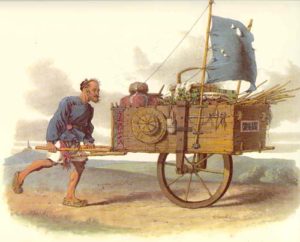
Posted: December 10th, 2016 | 2 Comments »
Terese Rudolph was a dancer, showgirl and world traveller. In 1937 she was working in Shanghai, dancing in nightclubs – she was a trained ballerina, tap dancer and all round entertainer originally from Chicago. she was working in the Cathay around the time the bombs fell outside the hotel in August 1937 (“Bloody Saturday”) and her mother was worried enough to inquire after her – thereby getting her picture in the paper Stateside. She was OK and carried on dancing in Shanghai for a while…but there’s more to Terese than just August 1937 in Shanghai….
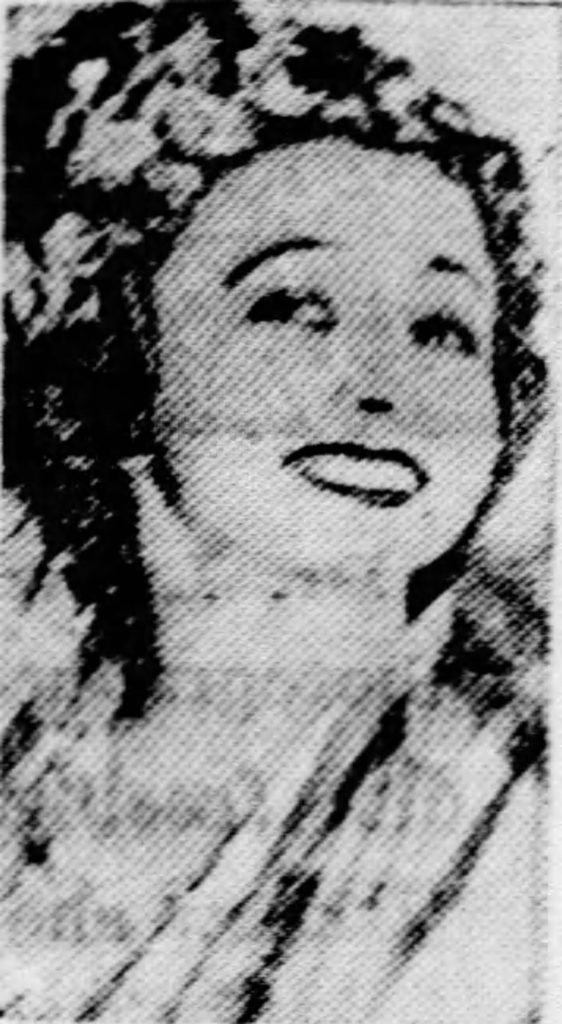
So here’s her story – Terese was born in 1913 in Budapest and came to America with her family when she was twelve years old. they settled in Chicago.She studied dance with Laurent Novikowf, who had once partnered Anna Pavlova. Apparently she never lost her Hungarian accent. At 17, she became a ballerina with the Chicago Civic Opera Company. In the early 1930s she appeared in various cabarets, nightclubs and reviews in the US and Canada as a “premiere danseuse” or “Hungarian Dancer” act. She was a smash all across the country – ballet, traditional Hungarian folk dancing and a little acrobatics thrown in for entertainment.
Somehow she travelled out to Shanghai and got a gig as the feature act at the Cathay Hotel. Her mum must have been wise to show business. She told the press in August 1937 she was concerned for her 21-year-old daughter in war-torn Shanghai – touching; Terese was over 24 by then. Here she is in her Cathay show…

When the bombs fell on the Cathay apparently Terese had hopped a steamer to Manila. But when she got there the city was paralysed by an earthquake so she hopped another steamer and sailed for Hong Kong – arriving right in the middle of a cholera epidemic. so she got a boat back to Shanghai. So she decided to use her last few dollars to get a ticket home to America. first all her trunks were left on the Bund and then she was left her ride home, the President Hoover, was accidentally strafed and bombed by the Chinese air force, though thankfully wasn’t sunk. however, one of her shapely dancers legs was scratched by glass from a smashed porthole. She got back to San Francisco on September 14th finally, took a train to Chicago and went straight to her mother’s house (also called Terese) on East 61st Street. I think we can all agree though that despite war, bombs, earthquakes, cholera and three weeks at sea Terese looked fantastic when she hit the dock at San Fran…and still with a sense of humour – Terese told the newsboys she’d invented a new dance in Shanghai, the “Shrapnel Swing”.
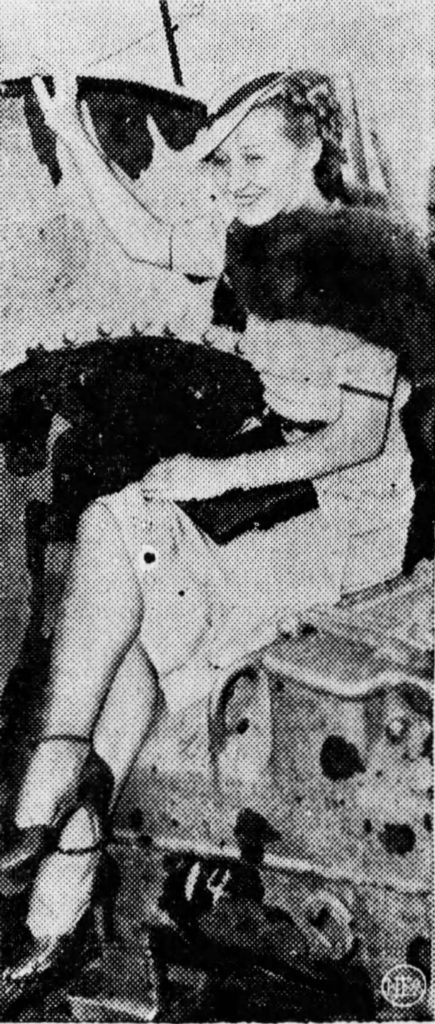
After Shanghai Terese was soon back in the swing dancing again in American nightclubs in 1938 and up till the start of WW2. Terese (who I think was known as “Teri” to her friends) joined the American United Service Organizations entertaining the troops during WW2. She appeared in America alongside an act called the Gloria Lee Girls. She was in Paris for the city’s liberation.
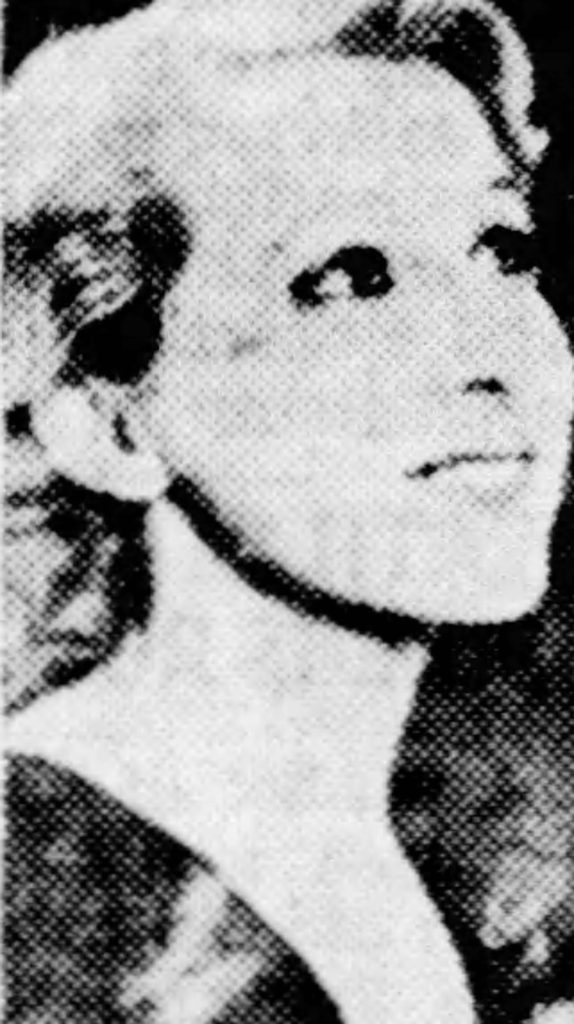
After the war she returned to America. In 1947 she appeared at the Copacabana in Miami Beach and danced in a review at the Rio Cabana Club in Chicago in 1947, where Billboard magazine noted her as the star of the show. She then went to run the American Army owned Casa Carioca in Garmisch, Germany, around 1949. The Casa Carioca had an ice skating rink attached and she helped train the ice skaters in dance to improve their shows (though she didn’t skate herself); the skaters were from all over – America, Scotland, Germany. Terese stayed in Garmisch till 1971. Terese Rudolph died of a heart attack at 92 in 2005.

Posted: December 9th, 2016 | No Comments »
A chance to see (and buy) some lovely pictures of old Hong Kong…
Wattis Fine Art est. 1988
Specialist Antique & Art Dealers
Hong Kong Illustrated 1843 – 1941
A collection of fine antique prints

(Charles Wirgman – The Illustrated London News – Man Mo Temple, Hollywood Road, Hong Kong 1858)
also featuring a magnificent oil painting of Hong Kong Harbour 1930 by Fred Taylor
The exhibition continues until Friday 23rd December 2016
Wattis Fine Art Gallery
20 Hollywood Road, 2/F, Central, Hong Kong
Gallery open: Monday – Saturday 11am – 6pm
Posted: December 8th, 2016 | 2 Comments »
It is, of course the 75th commemoration of the Japanese attack on Pearl Harbor. That attack meant America and Britain went to war with Japan and obviously had serious and long lasting consequences for China, Shanghai and Shanghailanders. It is also worth remembering that, due to the international date line, the Pearl Harbor attack on the 8th of December in China. this picture has always struck me especially, even though it is not taken in China….
Dec. 15, 1941, Ruth Lee, a hostess at a Chinese restaurant, flies a Chinese flag so she isn’t mistaken for Japanese when she sunbathes on her days off in Miami, in the wake of the attack on Pearl Harbor. Lee was born in the U.S.
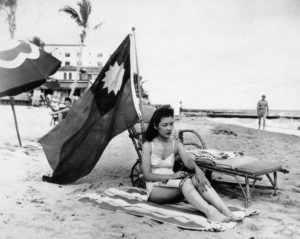
Posted: December 7th, 2016 | 2 Comments »
Some worrying news recently from some friends that visited a “heritage” conference in Shanghai that turned out to be far more about destruction than preservation. Among large number of buildings previously thought protected, but now not, one that stands out in my mind as I always enjoyed passing it and admiring it – the Yichang Road (formerly Ichang Road) Fire Station at 216 Yichang Road in Hongkou, which was formerly the Hongkew Fire Station (and is still a perfectly adequate functioning fire station).

The station was completed in 1932 – replacing an older station that stood there before and had become too small to cope with demand as the suburb of Hongkew expanded and became more densely populated. It is a classic Municipal Council design and opened for business in 1933. There was accommodation for four engines and twelve firemen, recreation rooms, kitchen etc etc. Rewi Alley got his first job in Shanghai at the station and passed his exams for engine driving, pump operation and started Shanghainese lessons while there.
I’m not going to argue about it – if this is bulldozed it will be a major tragedy and an act of vandalism – I’d like to say “unparalleled vandalism” but that wouldn’t be true in Shanghai given the last two decades of destruction.

Posted: December 6th, 2016 | No Comments »
I’ve been spotting opium references in popular culture with interest for a few years now (2015, 2014, 2013 & 2012) – just how opium keeps fascinating us…
What a start to the year with Sherlock on New Year’s Day dipping almost immediately into a Limehouse opium den – not much detail but dope mentioned plenty. Then came ITV’s Jericho, navvies ooop north in pain and needing their laudanum badly. Best perhaps in the first half of the year was the Maharajah’s mistress Sirene (aka Phyllis from Oz) who took a few puffs of opium from her natty little pipe at the Royal Simla Club in series 2 of Indian Summers. Of course series 3 (sadly it seems the final series) of Penny Dreadful went down into Chinatown while series 3 of those Peaky Blinders had them on the “snow” from episode 1 and getting seriously fu*ked up with some naughty White Russians.
 I got to it a bit late but season two of the 1870s French bordello drama Maison Close had Rose taking to the pipe as Mosca introduced her to the delights of balanced amounts of liquid cocaine and smoked opium which, if the show is to be believed, heightens all sorts of experiences.
I got to it a bit late but season two of the 1870s French bordello drama Maison Close had Rose taking to the pipe as Mosca introduced her to the delights of balanced amounts of liquid cocaine and smoked opium which, if the show is to be believed, heightens all sorts of experiences.
 let’s do the liquid cocaine first then…
let’s do the liquid cocaine first then…
Literary references were a bit scant this year (though that might be my reading of course) but M.J. Lee’s Inspector Danilov series (a third is out in 2017), set in 1920s Shanghai, has the White Russian super sleuth hitting the pipe to assuage the guilt of having lost his family somewhere between Minsk and the Bubbling Well Road – Death in Shanghai and City of Shadows are the first two Danilov books. We did also get a new biography of the great opium eater Thomas de Quincey – Frances Wilson’s Guilty Thing: A Life of Thomas de Quincey.

Patrick Hennessey explored Rudyard Kipling’s experiences of opium on hot Lahore summer nights in his BBC documentary Kipling’s Indian Adventure. And finally, of course, the ever reliable Ripper Street (series 5…and, sadly, the final one) had Jedediah Shine staving off his headaches with the opium pipe down in old Chinatown.
Any others do let me know…

Jedediah self-medicates in 1899 Limehouse
Posted: December 5th, 2016 | No Comments »
Homare Endo’s memoir, “Japanese Girl at the Siege of Changchun,†is written from the perspective of her 7-year-old self revealing the horror of one of the Chinese Civil War’s nastiest moments, when between 150,000 and 300,000 civilians starved to death during a five-month siege by People’s Liberation Army at Changchun in 1948.

Over 150,000 innocents died of starvation in Changchun, northeastern China, after the end of WW2 when Mao’s army laid siege during the Chinese Civil War. Japanese girl Homare Endo, then age seven, was trapped in Changchun with her family. After nomadic flight from city to city, Homare eventually returned to Japan and a professional career. This is her eyewitness, at times haunting account of survival at all costs and of unspeakable scenes of barbarity that the Chinese government today will not acknowledge.
Homare Endo was born in China in 1941 and is director of the Center of International Relations at Tokyo University and Graduate School of Social Welfare.
Posted: December 4th, 2016 | No Comments »
One canny photographer got a great shot that ran in many, many newspapers in the early 1920s – Shanghai – with a woman wearing trousers and two men, Scottish soldiers, wearing kilts. This picture ran in newspapers round the world in November 1924.
Now I’m rubbish at uniforms, regiments and all that so perhaps someone more knowledgeable can tell me if these gentleman are i) a Scottish regiment stationed in Shanghai at that time or b) members of the Scottish Company of the Shanghai Volunteer Corps??
